traction control Abarth 124 Spider 2020 Owner handbook (in English)
[x] Cancel search | Manufacturer: ABARTH, Model Year: 2020, Model line: 124 Spider, Model: Abarth 124 Spider 2020Pages: 224, PDF Size: 3.9 MB
Page 75 of 224
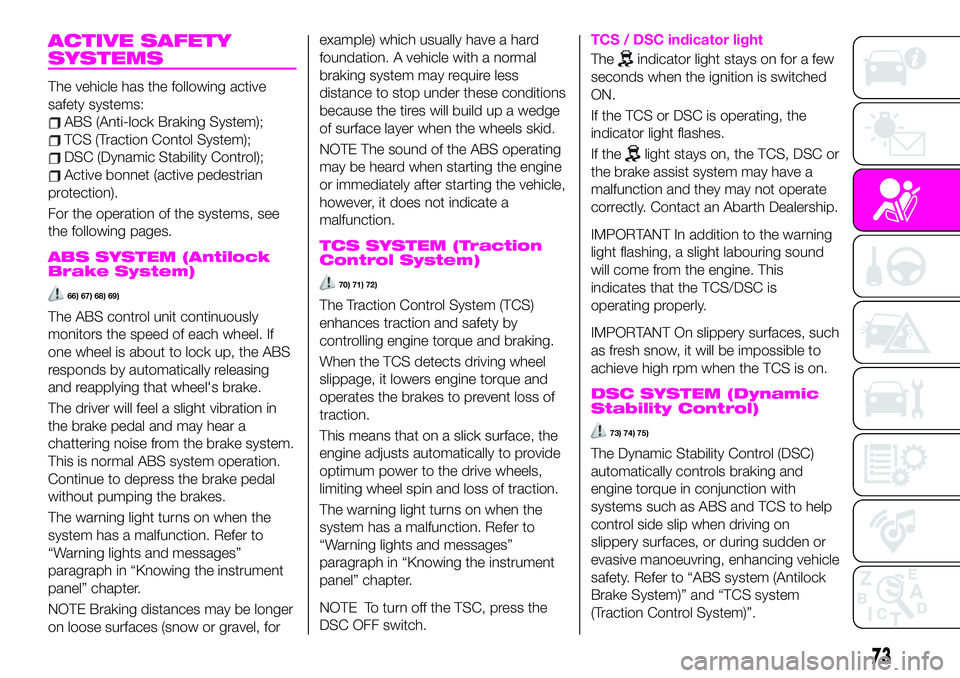
ACTIVE SAFETY
SYSTEMS
The vehicle has the following active
safety systems:
ABS (Anti-lock Braking System);
TCS (Traction Contol System);
DSC (Dynamic Stability Control);
Active bonnet (active pedestrian
protection).
For the operation of the systems, see
the following pages.
ABS SYSTEM (Antilock
Brake System)
66) 67) 68) 69)
The ABS control unit continuously
monitors the speed of each wheel. If
one wheel is about to lock up, the ABS
responds by automatically releasing
and reapplying that wheel's brake.
The driver will feel a slight vibration in
the brake pedal and may hear a
chattering noise from the brake system.
This is normal ABS system operation.
Continue to depress the brake pedal
without pumping the brakes.
The warning light turns on when the
system has a malfunction. Refer to
“Warning lights and messages”
paragraph in “Knowing the instrument
panel” chapter.
NOTE Braking distances may be longer
on loose surfaces (snow or gravel, forexample) which usually have a hard
foundation. A vehicle with a normal
braking system may require less
distance to stop under these conditions
because the tires will build up a wedge
of surface layer when the wheels skid.
NOTE The sound of the ABS operating
may be heard when starting the engine
or immediately after starting the vehicle,
however, it does not indicate a
malfunction.
TCS SYSTEM (Traction
Control System)
70) 71) 72)
The Traction Control System (TCS)
enhances traction and safety by
controlling engine torque and braking.
When the TCS detects driving wheel
slippage, it lowers engine torque and
operates the brakes to prevent loss of
traction.
This means that on a slick surface, the
engine adjusts automatically to provide
optimum power to the drive wheels,
limiting wheel spin and loss of traction.
The warning light turns on when the
system has a malfunction. Refer to
“Warning lights and messages”
paragraph in “Knowing the instrument
panel” chapter.
NOTE To turn off the TSC, press the
DSC OFF switch.
TCS / DSC indicator light
Theindicator light stays on for a few
seconds when the ignition is switched
ON.
If the TCS or DSC is operating, the
indicator light flashes.
If the
light stays on, the TCS, DSC or
the brake assist system may have a
malfunction and they may not operate
correctly. Contact an Abarth Dealership.
IMPORTANT In addition to the warning
light flashing, a slight labouring sound
will come from the engine. This
indicates that the TCS/DSC is
operating properly.
IMPORTANT On slippery surfaces, such
as fresh snow, it will be impossible to
achieve high rpm when the TCS is on.
DSC SYSTEM (Dynamic
Stability Control)
73) 74) 75)
The Dynamic Stability Control (DSC)
automatically controls braking and
engine torque in conjunction with
systems such as ABS and TCS to help
control side slip when driving on
slippery surfaces, or during sudden or
evasive manoeuvring, enhancing vehicle
safety. Refer to “ABS system (Antilock
Brake System)” and “TCS system
(Traction Control System)”.
73
Page 78 of 224
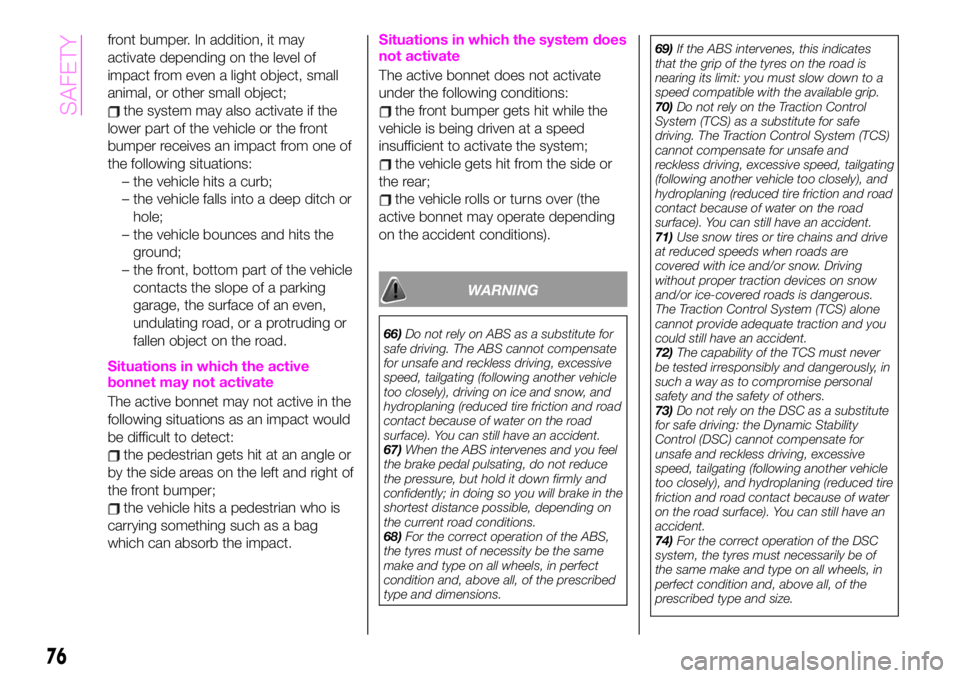
front bumper. In addition, it may
activate depending on the level of
impact from even a light object, small
animal, or other small object;
the system may also activate if the
lower part of the vehicle or the front
bumper receives an impact from one of
the following situations:
– the vehicle hits a curb;
– the vehicle falls into a deep ditch or
hole;
– the vehicle bounces and hits the
ground;
– the front, bottom part of the vehicle
contacts the slope of a parking
garage, the surface of an even,
undulating road, or a protruding or
fallen object on the road.
Situations in which the active
bonnet may not activate
The active bonnet may not active in the
following situations as an impact would
be difficult to detect:
the pedestrian gets hit at an angle or
by the side areas on the left and right of
the front bumper;
the vehicle hits a pedestrian who is
carrying something such as a bag
which can absorb the impact.
Situations in which the system does
not activate
The active bonnet does not activate
under the following conditions:
the front bumper gets hit while the
vehicle is being driven at a speed
insufficient to activate the system;
the vehicle gets hit from the side or
the rear;
the vehicle rolls or turns over (the
active bonnet may operate depending
on the accident conditions).
WARNING
66)Do not rely on ABS as a substitute for
safe driving. The ABS cannot compensate
for unsafe and reckless driving, excessive
speed, tailgating (following another vehicle
too closely), driving on ice and snow, and
hydroplaning (reduced tire friction and road
contact because of water on the road
surface). You can still have an accident.
67)When the ABS intervenes and you feel
the brake pedal pulsating, do not reduce
the pressure, but hold it down firmly and
confidently; in doing so you will brake in the
shortest distance possible, depending on
the current road conditions.
68)For the correct operation of the ABS,
the tyres must of necessity be the same
make and type on all wheels, in perfect
condition and, above all, of the prescribed
type and dimensions.69)If the ABS intervenes, this indicates
that the grip of the tyres on the road is
nearing its limit: you must slow down to a
speed compatible with the available grip.
70)Do not rely on the Traction Control
System (TCS) as a substitute for safe
driving. The Traction Control System (TCS)
cannot compensate for unsafe and
reckless driving, excessive speed, tailgating
(following another vehicle too closely), and
hydroplaning (reduced tire friction and road
contact because of water on the road
surface). You can still have an accident.
71)Use snow tires or tire chains and drive
at reduced speeds when roads are
covered with ice and/or snow. Driving
without proper traction devices on snow
and/or ice-covered roads is dangerous.
The Traction Control System (TCS) alone
cannot provide adequate traction and you
could still have an accident.
72)The capability of the TCS must never
be tested irresponsibly and dangerously, in
such a way as to compromise personal
safety and the safety of others.
73)Do not rely on the DSC as a substitute
for safe driving: the Dynamic Stability
Control (DSC) cannot compensate for
unsafe and reckless driving, excessive
speed, tailgating (following another vehicle
too closely), and hydroplaning (reduced tire
friction and road contact because of water
on the road surface). You can still have an
accident.
74)For the correct operation of the DSC
system, the tyres must necessarily be of
the same make and type on all wheels, in
perfect condition and, above all, of the
prescribed type and size.
76
SAFETY
Page 81 of 224

When changing tires yourself:ifyou
or someone else changes tires, you or
someone else can also undertake the
steps for the TPMS to complete the ID
signal code registration:
after tires have been changed, switch
the ignition ON, then back to ACC or
OFF;
wait for about 15 minutes;
after about 15 minutes, drive the
vehicle at a speed of at least 25 km/h
for 10 minutes and the tire pressure
sensor ID signal code will be registered
automatically.
IMPORTANT If the vehicle is driven
within about 15 minutes of changing
tires, the
warning light will flash
because the sensor ID signal code
would not have been registered. If this
happens, park the vehicle for about
15 minutes, after which the sensor ID
signal code will register upon driving the
vehicle for 10 minutes.
Replacing tires and wheels
IMPORTANT When replacing/repairing
the tires or wheels or both, have the
work done by an Abarth Dealership, or
the tire pressure sensors may be
damaged.
IMPORTANT The wheels equipped on
your vehicle are specially designed for
installation of the tire pressure sensors.Do not use non-genuine wheels,
otherwise it may not be possible to
install the tire pressure sensors.
Be sure to have the tire pressure
sensors installed whenever tires or
wheels are replaced.
When having a tire or wheel or both
replaced, the following types of tire
pressure sensor installations are
possible:
the tire pressure sensor is removed
from the old wheel and installed to the
new one;
the same tire pressure sensor is used
with the same wheel. Only the tire is
replaced;
a new tire pressure sensor is installed
to a new wheel.
IMPORTANT The tire pressure sensor
ID signal code must be registered when
a new tire pressure sensor is
purchased. For purchase of a tire
pressure sensor and registration of the
tire pressure sensor ID signal code,
consult an Abarth Dealership.
IMPORTANT When reinstalling a
previously removed tire pressure sensor
to a wheel, replace the grommet (seal
between valve body/sensor and wheel)
for the tire pressure sensor.
MECHANICAL LIMITED
SLIP DIFFERENTIAL
Your vehicle is equipped with a
mechanical limited slip differential. In
particular this vehicle adopts a
super-LSD which guarantees improved
vehicle traction and handling.
A super-LSD with a low torque bias
ratio (*) has been adopted to improve
performance when starting from a
standstill, driving straight-ahead and
response.
(*)Torque bias ratio: when a wheel
slips due to a low-traction surface, the
LSD provides proportionally more
torque to the opposite wheel. The
torque bias ratio is the ratio of torque
supplied to the right and left wheels in
such cases, and represents the
performance capability of the LSD.
The super-LSD is a torque-sensing type
that provides improved driving stability
due to the following characteristics:
low torque bias ratio provides
improved controllability (torque bias
ratio: 2.0);
creation of initial torque provides
improved starting from a standstill and
acceleration/deceleration response, and
driving straight-ahead (initial torque:
49 Nm);
simplified construction provides
weight reduction.
79
Page 82 of 224
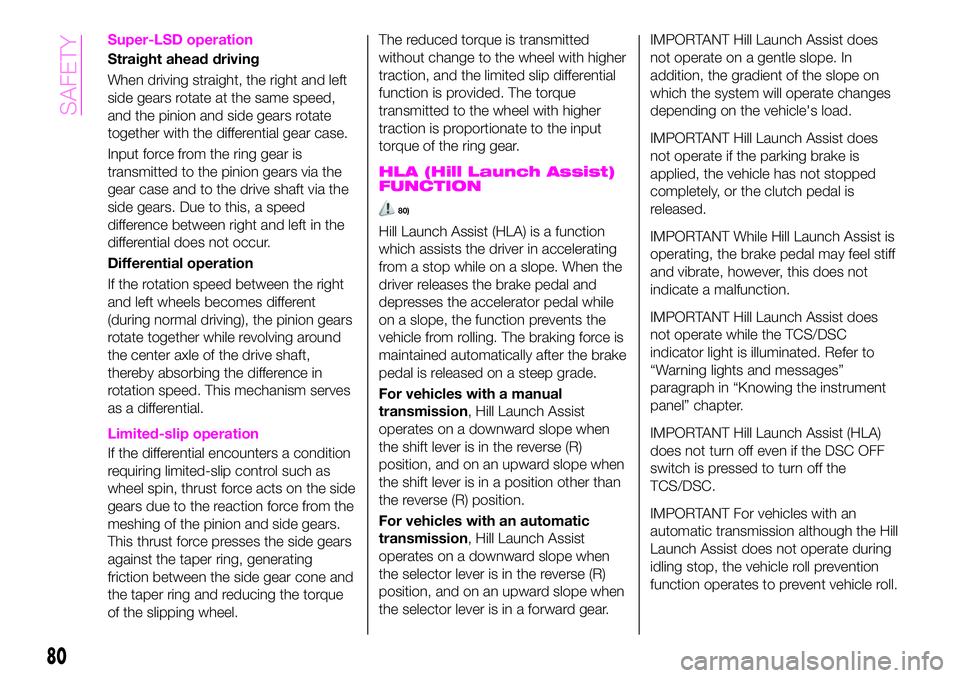
Super-LSD operation
Straight ahead driving
When driving straight, the right and left
side gears rotate at the same speed,
and the pinion and side gears rotate
together with the differential gear case.
Input force from the ring gear is
transmitted to the pinion gears via the
gear case and to the drive shaft via the
side gears. Due to this, a speed
difference between right and left in the
differential does not occur.
Differential operation
If the rotation speed between the right
and left wheels becomes different
(during normal driving), the pinion gears
rotate together while revolving around
the center axle of the drive shaft,
thereby absorbing the difference in
rotation speed. This mechanism serves
as a differential.
Limited-slip operation
If the differential encounters a condition
requiring limited-slip control such as
wheel spin, thrust force acts on the side
gears due to the reaction force from the
meshing of the pinion and side gears.
This thrust force presses the side gears
against the taper ring, generating
friction between the side gear cone and
the taper ring and reducing the torque
of the slipping wheel.The reduced torque is transmitted
without change to the wheel with higher
traction, and the limited slip differential
function is provided. The torque
transmitted to the wheel with higher
traction is proportionate to the input
torque of the ring gear.
HLA (Hill Launch Assist)
FUNCTION
80)
Hill Launch Assist (HLA) is a function
which assists the driver in accelerating
from a stop while on a slope. When the
driver releases the brake pedal and
depresses the accelerator pedal while
on a slope, the function prevents the
vehicle from rolling. The braking force is
maintained automatically after the brake
pedal is released on a steep grade.
For vehicles with a manual
transmission, Hill Launch Assist
operates on a downward slope when
the shift lever is in the reverse (R)
position, and on an upward slope when
the shift lever is in a position other than
the reverse (R) position.
For vehicles with an automatic
transmission, Hill Launch Assist
operates on a downward slope when
the selector lever is in the reverse (R)
position, and on an upward slope when
the selector lever is in a forward gear.
IMPORTANT Hill Launch Assist does
not operate on a gentle slope. In
addition, the gradient of the slope on
which the system will operate changes
depending on the vehicle's load.
IMPORTANT Hill Launch Assist does
not operate if the parking brake is
applied, the vehicle has not stopped
completely, or the clutch pedal is
released.
IMPORTANT While Hill Launch Assist is
operating, the brake pedal may feel stiff
and vibrate, however, this does not
indicate a malfunction.
IMPORTANT Hill Launch Assist does
not operate while the TCS/DSC
indicator light is illuminated. Refer to
“Warning lights and messages”
paragraph in “Knowing the instrument
panel” chapter.
IMPORTANT Hill Launch Assist (HLA)
does not turn off even if the DSC OFF
switch is pressed to turn off the
TCS/DSC.
IMPORTANT For vehicles with an
automatic transmission although the Hill
Launch Assist does not operate during
idling stop, the vehicle roll prevention
function operates to prevent vehicle roll.
80
SAFETY
Page 180 of 224
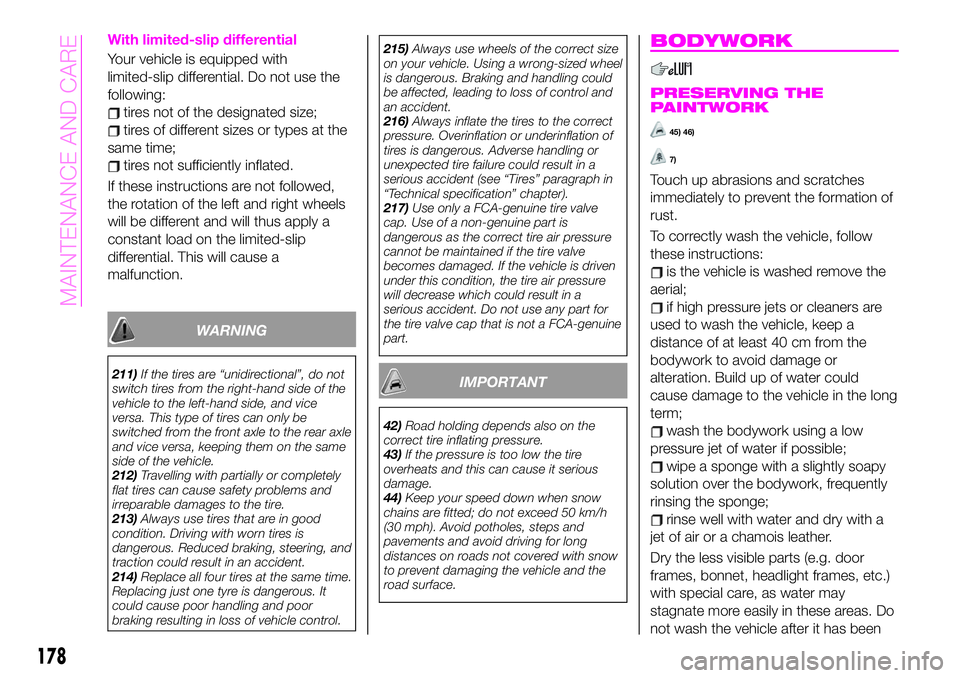
With limited-slip differential
Your vehicle is equipped with
limited-slip differential. Do not use the
following:
tires not of the designated size;
tires of different sizes or types at the
same time;
tires not sufficiently inflated.
If these instructions are not followed,
the rotation of the left and right wheels
will be different and will thus apply a
constant load on the limited-slip
differential. This will cause a
malfunction.
WARNING
211)If the tires are “unidirectional”, do not
switch tires from the right-hand side of the
vehicle to the left-hand side, and vice
versa. This type of tires can only be
switched from the front axle to the rear axle
and vice versa, keeping them on the same
side of the vehicle.
212)Travelling with partially or completely
flat tires can cause safety problems and
irreparable damages to the tire.
213)Always use tires that are in good
condition. Driving with worn tires is
dangerous. Reduced braking, steering, and
traction could result in an accident.
214)Replace all four tires at the same time.
Replacing just one tyre is dangerous. It
could cause poor handling and poor
braking resulting in loss of vehicle control.215)Always use wheels of the correct size
on your vehicle. Using a wrong-sized wheel
is dangerous. Braking and handling could
be affected, leading to loss of control and
an accident.
216)Always inflate the tires to the correct
pressure. Overinflation or underinflation of
tires is dangerous. Adverse handling or
unexpected tire failure could result in a
serious accident (see “Tires” paragraph in
“Technical specification” chapter).
217)Use only a FCA-genuine tire valve
cap. Use of a non-genuine part is
dangerous as the correct tire air pressure
cannot be maintained if the tire valve
becomes damaged. If the vehicle is driven
under this condition, the tire air pressure
will decrease which could result in a
serious accident. Do not use any part for
the tire valve cap that is not a FCA-genuine
part.IMPORTANT
42)Road holding depends also on the
correct tire inflating pressure.
43)If the pressure is too low the tire
overheats and this can cause it serious
damage.
44)Keep your speed down when snow
chains are fitted; do not exceed 50 km/h
(30 mph). Avoid potholes, steps and
pavements and avoid driving for long
distances on roads not covered with snow
to prevent damaging the vehicle and the
road surface.
BODYWORK
PRESERVING THE
PAINTWORK
45) 46)
7)
Touch up abrasions and scratches
immediately to prevent the formation of
rust.
To correctly wash the vehicle, follow
these instructions:
is the vehicle is washed remove the
aerial;
if high pressure jets or cleaners are
used to wash the vehicle, keep a
distance of at least 40 cm from the
bodywork to avoid damage or
alteration. Build up of water could
cause damage to the vehicle in the long
term;
wash the bodywork using a low
pressure jet of water if possible;
wipe a sponge with a slightly soapy
solution over the bodywork, frequently
rinsing the sponge;
rinse well with water and dry with a
jet of air or a chamois leather.
Dry the less visible parts (e.g. door
frames, bonnet, headlight frames, etc.)
with special care, as water may
stagnate more easily in these areas. Do
not wash the vehicle after it has been
178
MAINTENANCE AND CARE
Page 220 of 224
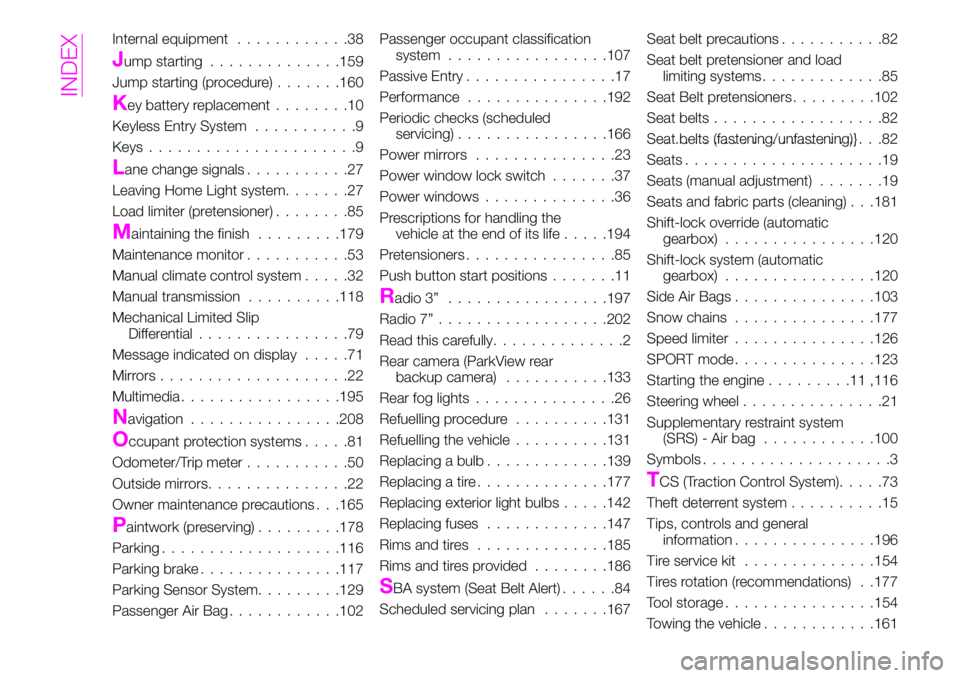
Internal equipment............38
Jump starting..............159
Jump starting (procedure).......160
Key battery replacement........10
Keyless Entry System...........9
Keys......................9
Lane change signals...........27
Leaving Home Light system.......27
Load limiter (pretensioner)........85
Maintaining the finish.........179
Maintenance monitor...........53
Manual climate control system.....32
Manual transmission..........118
Mechanical Limited Slip
Differential................79
Message indicated on display.....71
Mirrors....................22
Multimedia.................195
Navigation................208
Occupant protection systems.....81
Odometer/Trip meter...........50
Outside mirrors...............22
Owner maintenance precautions . . .165
Paintwork (preserving).........178
Parking...................116
Parking brake...............117
Parking Sensor System.........129
Passenger Air Bag............102Passenger occupant classification
system.................107
Passive Entry................17
Performance...............192
Periodic checks (scheduled
servicing)................166
Power mirrors...............23
Power window lock switch.......37
Power windows..............36
Prescriptions for handling the
vehicle at the end of its life.....194
Pretensioners................85
Push button start positions.......11
Radio 3”.................197
Radio 7”..................202
Read this carefully..............2
Rear camera (ParkView rear
backup camera)...........133
Rear fog lights...............26
Refuelling procedure..........131
Refuelling the vehicle..........131
Replacing a bulb.............139
Replacing a tire..............177
Replacing exterior light bulbs.....142
Replacing fuses.............147
Rims and tires..............185
Rims and tires provided........186
SBA system (Seat Belt Alert)......84
Scheduled servicing plan.......167Seat belt precautions...........82
Seat belt pretensioner and load
limiting systems.............85
Seat Belt pretensioners.........102
Seat belts..................82
Seat belts (fastening/unfastening)}.......................82
Seats.....................19
Seats (manual adjustment).......19
Seats and fabric parts (cleaning) . . .181
Shift-lock override (automatic
gearbox)................120
Shift-lock system (automatic
gearbox)................120
Side Air Bags...............103
Snow chains...............177
Speed limiter...............126
SPORT mode...............123
Starting the engine.........11,116
Steering wheel...............21
Supplementary restraint system
(SRS) - Air bag............100
Symbols....................3
TCS (Traction Control System).....73
Theft deterrent system..........15
Tips, controls and general
information...............196
Tire service kit..............154
Tires rotation (recommendations) . .177
Tool storage................154
Towing the vehicle............161
INDEX